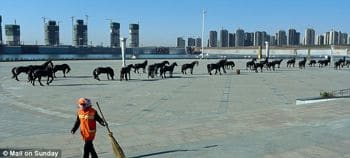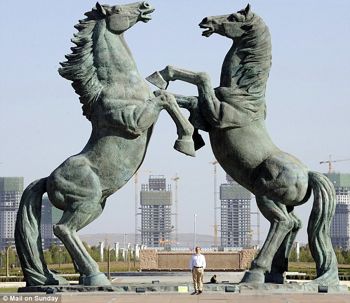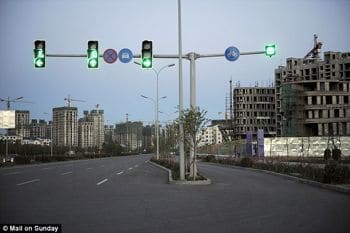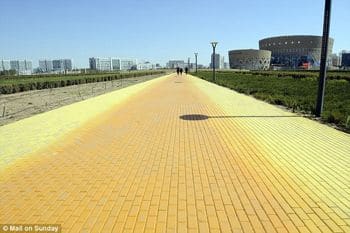
 The Chinese strain: the rise of empty cities for missing millionaires.
The Chinese strain: the rise of empty cities for missing millionaires.
It seems to have become the prevailing stasis of China’s ascent to world dominance that the many things that they once created, rather than being received by overwhelming demand and participation are now being increasingly received with the reality of a metaphorical silence of an empty pin drop thud. Thud, because newly created cities, meant for millions are just sitting there empty and solitary- so bare and vacant that the loudest things one can hear is that of a pin dropping to the dizzy asphalt. Should anyone be standing there in the first place to hear it that is…
More to the point, many Chinese aspirations are now being realized as an overblown speculative bubble inverted on its head where the thing being imagined now just sit there like a silent mausoleum unto itself- a victim of its dizzy ascent and aspiration to the vortex of ever increasing Chinese consumption, which for the last ten years had been growing at a steady rate of 10% while world growth dissipated.
dailymailco.uk: So there is no joy in asking if China has outgrown its strength after ten years of blazing, enthralling growth. But it may have done so. The hedge-fund managers, those canny vultures of finance, are beginning to circle slowly, high overhead. They are starting to bet on the bursting of the Chinese bubble. These people did not become very rich indeed by guessing wrong.
And one of the reasons for their gloomy guesswork is here, in the strange, wistful landscape of Inner Mongolia, birthplace and home of Genghis Khan.
The city in question, Kangbashi, which serves to suggest that indeed China’s speculative boom might be now ready to take a vicious tumble reads like a distraught widow caught in a thunderstorm with nary an eye flicker to assuage her guilt, sense of longing or bereavement.
Seen from space, Kangbashi is a metropolis fit to hold a million busy, prosperous people, with sweeping boulevards, a spacious central square, homes, factories and offices spread over 12 square miles and a wide river running through it.
In its publicity, Kangbashi is a super-modern megalomaniac’s dream. There is a sculpture park containing dozens of abstract figures in faintly obscene embraces, standing for the unity of the people and the Chinese armed forces.
The whims of modern architects have been indulged, with a drum-shaped concert hall that looks much like a sawn-off cooling tower, and a leaning library built to resemble a shelf of books – next to a sort of giant cowpat coated in reflective bronze, perhaps symbolising Inner Mongolia’s dairy industry.
Seen from the new expressway which leads to it, it is a majestic line of towers in the haze. But at ground level there is something severely wrong. Traffic is slowed because a huge advertising hoarding has fallen from a bridge on to the carriageway. Like so much of modern China, sparkling at a distance, grubby and cracked close to, the reality does not quite live up to the appearance.

The reality does not fit up to the appearance? Isn’t this the precursor that so often precedes many a downfall of rollicky civilizations? Civilizations seduced by their own grandeur, stasis, might and impending glory to another dizzy height and achievement?
For it is from on high that instructions came to encourage local business to invest in this place, which previously contained two insignificant villages with about 1,500 people in them. And it is from on high that the will and force come, which have created a city out of nothing on the empty steppe.
This was the deal, binding Communist Party, state, military and businessmen. The local government would build the roads, the schools and the infrastructure. The investors would bring the car factory (now working), the business headquarters and the rest. The police and the army would occupy major buildings.
Together, they planned to spend £1.7 billion on the theory that, if you build it, they will come. Wealthy Chinese would buy the apartments and the place would soon fill with people.
But the people to date have not come.
Some way from the rest of the aborted, futile township is an entire courthouse, surrounded by scrub and rough earth, its flagpoles empty, its crumbling steps adorned with stylised stone lions and its top storeys adorned with the (slightly uneven looking) scales of Chinese justice. But ghostliest and bleakest of all is an unused prison, watchtowers and all, waiting for convicts whose crimes will never be committed – because the place where they would have happened has never had any people in it.
How ironic that the thing that the Chinese prepare themselves for fails to materialize. Borne out of speculation and an iron will that the next upward revolution must come, whole communities have invested in these projects only to be left with the daunting reality that there is in fact no one left to buy into the great apparatus that officials insist they must buy into.
After all it’s one thing to buy the thing that one is told to have, but it is another thing not to enjoy it or make use of it after the sudden realization one barely has the appetite or the financial appetite/means to negotiate it. But this is so often the case of the speculator who chiefly buys not because they envisage themselves living in these swaths of cities but others.It is when the reality that the locals can not and do not want to live there that the chasm between reality and aspirations become most apparent. It is to be sure when one can hear the loud thud of a dropping pin in the empty city of Kangbashi.









I just had a visit to the so called “Ghost Town”. The fact published in the past may be true. But the prediction is very questionable in my opinion from what I saw and learned about its future. Yes, there are still many empty homes there and they may not be occupied in the near future. However, they is no similarity to the homes here deserted by their owners. The town along with the surrounding area is being developed and most of the homes are occupied. The owners have no difficulty to sell them if they want to. The price has risen so much in the last a few years that even if home price drop by half the owners are not going to lose money. These owners mostly do not have a mortgage at all. You have to ask yourself, where those peoples’ confidence is from. Or are they just like those in the US caught by the housing bubble.
The area is rich in coal, natural gas and oil. The Orus (the district Kangbashi is located in, also call Dongsheng) has the highest GDP per capital, ahead of Hong Kong. So far only coal deposit has been touched. People get loyalty payment from mining firms. And the government also pays farmers to leave their land behind. People have a lot of money on hands to spend and invest. The industrial development is indeed lagging housing development. But I do not see a potential problem if the factories do not come within the next five years. There might be a housing bubble in China, but taking Kangbashi as an example will certainly be the wrong pick.
You have to know how things in China works before you make a point. The owners pay no property tax at all now. The high rising buildings are made of solid reinforced concrete. You pay almost nothing for maintenance. Therefore, the cost of ownership is super low. The only cost is association fee (0.2%) if you don’t have a mortgage.
I agree – Inner Mongolia and Mongolia are the same place historically, though not politically TODAY. The Russians took a chunk from China of what is now the former soviet republic of Mongolia, an independent country. However outer Mongolia was always part of China in the past.
Mongolians live on both sides of the border with more Mongolians living in China than in the Mongolian republic.
Yes, Mongolian identity is under cultural pressures in China from Han majority.
Chinggis Khan didn’t capture any Inner Mongolia, Mongolians lived and still live there so there was nothing to captured at the time. Mongolians are people of the grasslands and never had a country until less than a hundred years ago. It is only by political borders that there is a country called Mongolia. But there are other millions of Mongolians outside it, struggling every day against other opressing cultures to keep Chinggis Khan’s inheritance alive. Don’t get Mongolian people’s history wrong.
Chinggis Khan was not born in Inner Mongolia. He was born, and lived most of his life, in northern Mongolia, today’s sovereign nation. He captured Inner Mongolia, along with much of China, and ruled it.
Please get it straight. Inner Mongolia and Mongolia are not the same place.
Chingis Khan was born in Khenti, Mongolia – not China. Big difference.